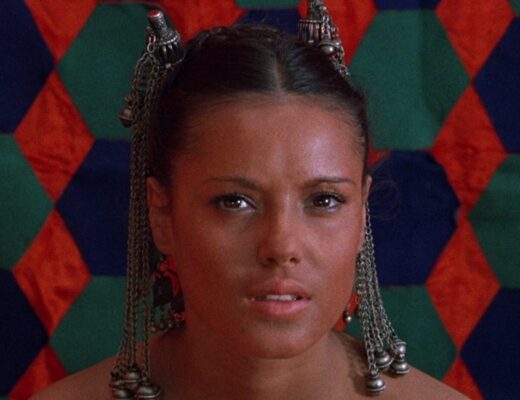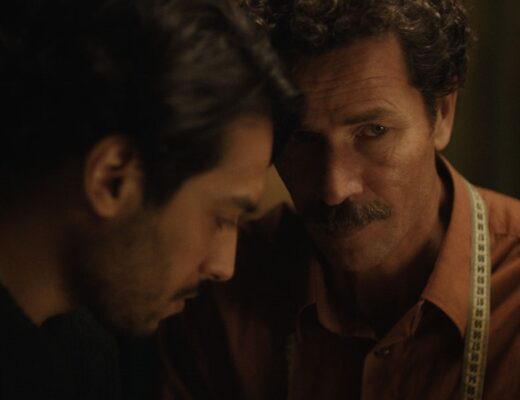As with the latest films by Manoel de Oliveira and — prior to his recent passing — Raul Ruiz, it’s tempting to digest a new film by the 91-year-old French director Alain Resnais as an all-encompassing swan song, a final testament on the filmmaker’s accumulated thoughts on cinema and life. It becomes especially seductive, albeit worrisome, when taking into account the surface parallels between Resnais’s new movie and the final works of those two directors. Like Ruiz’s Night Across the Street, Resnais’s latest features actors who function less as autonomous characters than as vessels through which various past selves, both performative and “real,” vicariously merge. Resnais and Ruiz also share a propensity for antiquated techniques — split diopters, iris-ins, unnervingly conspicuous green-screen work, Georges Méliès-like disappearing acts — that look especially dated when created with digital post-production technology. And like Oliveira, Resnais seems content to center a film around decidedly old-world individuals — actors, artists, intellectuals — who convene in confined spaces that serve as arenas for hardened monologues on life, love and art.
But in spite of these surface parallels, it’s important to remember that Resnais’s new film is called You Ain’t Seen Nothin’ Yet, a title that seems to imply — no, boast — to its audience that the famously restless artist is not about to run out of new ideas just yet. And although You Ain’t Seen Nothin’ Yet essentially violates its titular promise by recycling themes and scenarios that we’ve seen from Resnais dozens of times over the decades — namely, the intersection of life and art, the cyclical yet distorting nature of memory, conversation as a form of therapy and self-exploration, and the central premise of gathering well-dressed adults in a mysteriously shifting temporary oasis — the film still offers up its own cluster of surprises.
The first of these surprises arrives before the film proper even begins. As a thick computer-generated troposphere fills the screen in shades of Egyptian blue and rust and a crashing, capital-M movie score ushers in the credit sequence, you might wonder if you’ve accidentally started watching a Mel Brooks science-fiction spoof. The film’s title shows up in a blocky, brick-red typeface not unlike the one used in the American posters for Wisit Sasanatieng’s Tears of the Black Tiger (2000), and ancient Greek iconography is superimposed over the amorphous image. It’s difficult to gauge the film’s tone right off the bat: sincerity, irreverence, or outright farce? This uncertainty is only compounded by an odd, clunky prologue that redundantly introduces the film’s cast of French performing-arts legends: first in a series of behind-the-head close-ups, then again as they arrive one-by-one at the mountain estate where the rest of the story takes place.
The film finds its footing soon after, though, when the ensemble finishes filing into the building and Resnais calmly presents his conceit. A recently deceased, fictional playwright named Antoine d’Anthac (Denis Podalydès) has invited two generations of actors whom he has directed before in his various renditions of the Greek myth Eurydice to his remote manor for a reading of his final will. Instead of a conventional wake, however, they get a screening of d’Anthac’s latest adaptation of Eurydice, a cheaply made, near-avant-garde video spectacle in an alleyway somewhere in France comprising a cast of po-faced twentysomethings. Michel Piccoli, Mathieu Amalric, Sabine Azéma, Pierre Arditi, Anne Consigny, and Lambert Wilson are all among the attendees, playing themselves more or less — so, needless to say, these kids have a stiff test audience.
If this does wind up being Resnais’s farewell—and let’s hope it doesn’t—it’s a fittingly substantial and wise one.
Despite its tidy four-act structure, mapped to that of the video production, the film goes into plenty of unpredictable directions from here. As the play progresses, d’Anthac’s guests are increasingly inspired by the young performers to resurrect their own vaguely recalled memories of past performances, in turn paying less attention to the screen and more to their fellow thespians. Layers of performance and memory topple messily over one another until the film loses any stable sense of present-tense reality. At one point, in a fit of actorly charisma, Azema tells Arditi with a straight face, “it’s as if we just met for the third time.” This absurd line starts to make crystal-clear sense in the context of the film’s dense tangle of exhumed fictional selves, half-remembered plot lines and character motivations. Resnais builds the film from lengthy, passionately acted chunks of dialogue, all shot with loving cinematographic embellishments — but any suspicions of rigid theatricality or a mere actor’s showcase are undermined by the film’s inspired editing, which routinely disrupts empathetic engagement in the scattered narratives of betrayal and desire to shift to other actors riffing on (living?) an interchangeable scenario.
For those entirely unaware or with only a sketchy familiarity with Eurydice, it’s nearly impossible to discern the extent to which the script’s barrage of double-crosses and suggestions of infidelity are germane to the ancient story’s characters or if the several different generations of actors in d’Anthac’s renditions are filling in their own dramas from both memories of the material and their of-the-moment hopes and anxieties. This fuzziness between the textual and extra-textual elements is, I imagine, not only intentional in Resnais’s knotty design, but encouraged to allow us to better drift into the film’s porous representations of time, reality and performance. As in the director’s Last Year at Marienbad (1961), the past, present and future all seem to be coinciding at once. Snippets of soundtrack music, clearly written and recorded with the original intention of providing some kind of emphasis on the dramatic tone of a given scene, dance around the mix without ever indicating emotion in the manner in which they were conceived, instead coming across like ghosts of prior productions of the same material. Cast members from the video version of Eurydice stare directly at the viewer and even interact with the guests, prophetic gestures that are echoed by the actors’ own fourth-wall disturbances.
All of which is to say that the film proudly reveals, even revels in, its own artifice; sets that magically transform through awkward digital compositing — d’Anthac’s opulent foyer repeatedly becomes an undisturbed train station lobby, for instance — and figures that mischievously materialize in rooms (Hippolyte Girardot is a regular culprit) only reinforce this notion. None of this is to imply that the film lacks dramatic heft or emotional stakes, though; if anything, the fact that the performances in You Ain’t Seen Nothin’ Yet are explicitly recognized as emerging from a fictional place allows their spontaneous emergence to be all the more affecting. Ultimately, the film reveals itself to be a portrait of people who have been fundamentally altered by their decades of involvement in performance, if not by specific narrative details then at least by the emotional and thematic undertones of the work to which they’ve given themselves. If this does wind up being Resnais’s farewell — and let’s hope it doesn’t — it’s a fittingly substantial and wise one.







